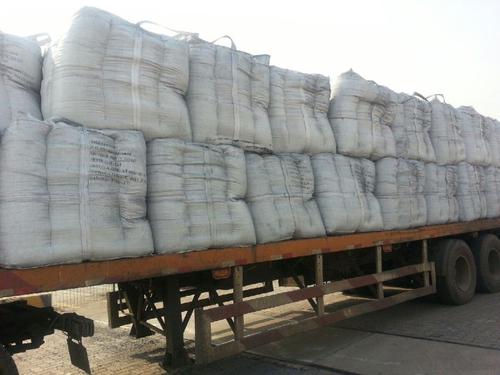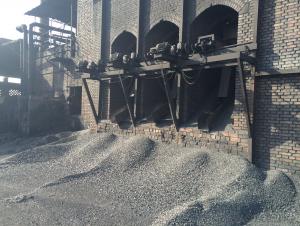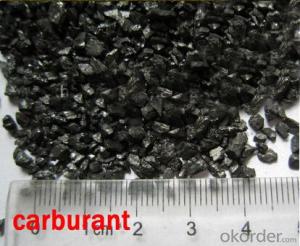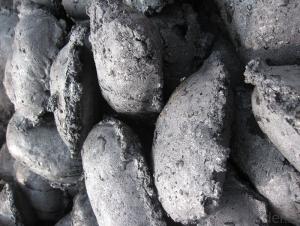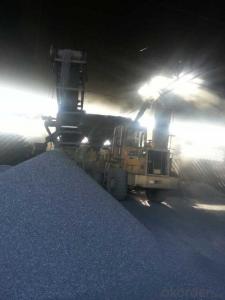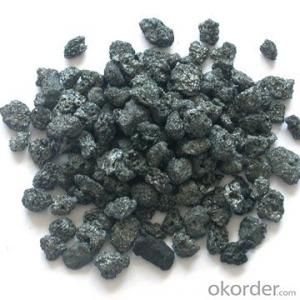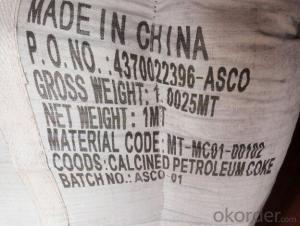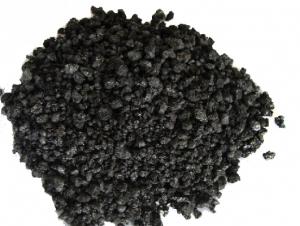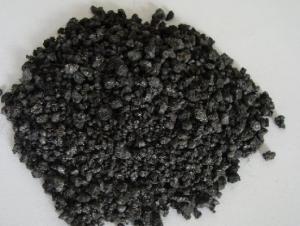Calcined Peroleum Coke with FC 98.5% S 0.55%
- Loading Port:
- Tianjin
- Payment Terms:
- TT OR LC
- Min Order Qty:
- 20 m.t.
- Supply Capability:
- 2000 m.t./month
OKorder Service Pledge
OKorder Financial Service
You Might Also Like
Packaging & Delivery
25kgs/50kgs/1ton per bag or as buyer's request
Calcined Petroleum Coke is a critical ingredient in the production of Metallurgy and chemical industrial ,it can increase the used quantity of Scrap steel and reduce the quantity of Scrap iron, or use no Scrap iron at all, the calcined petroleum coke has follow properties: high absorptive character, no residue will be left and save production cost.
Specifications
Calcined Anthracite
1.low sulphur, low ash
2.fixed carbon:95% -90%
3.sulphur:lower than 0.3%
4.Calcined Anthracite Coal
Advantage and competitive of caclined anthracite:
1. strong supply capability
2. fast transportation
3. lower and reasonable price for your reference
4.low sulphur, low ash
5.fixed carbon:95% -90%
6..sulphur:lower than 0.3%
General Specification of Calcined Anthracite:
| FC % | 98.5 | 98.5 | 98.5 | 99 |
| ASH % | 0.8 | 0.8 | 0.8 | 0.5 |
| V.M. % | 0.7 | 0.7 | 0.7 | 0.5 |
| S % | 0.5 | 0.55 | 0.7 | 0.5 |
| MOISTURE % | 0.5 | 0.5 | 0.5 | 0.5 |
Picture of CPC/ Calcined Petroleum Coke
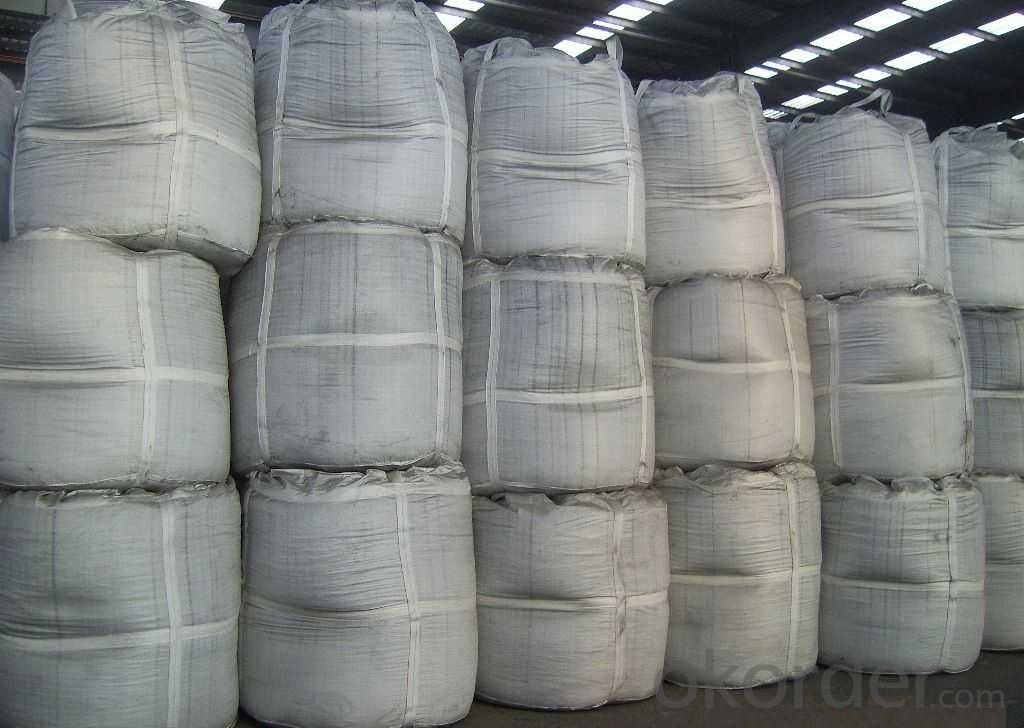
- Q: What is carbon offsetting in the fashion industry?
- Carbon offsetting in the fashion industry refers to the practice of compensating for the greenhouse gas emissions produced during the production, transportation, and disposal of clothing and accessories. This process involves investing in projects or activities that reduce or remove an equivalent amount of carbon dioxide (CO2) from the atmosphere to offset the emissions generated by the industry. Fashion is known for its significant contribution to environmental degradation, with the production of textiles, manufacturing processes, and transportation all contributing to carbon emissions. Carbon offsetting provides a way for fashion brands and companies to take responsibility for their carbon footprint and work towards reducing their environmental impact. There are various ways in which carbon offsetting is implemented in the fashion industry. One common method is through the support of renewable energy projects, such as wind farms or solar power plants, which generate clean energy and reduce the reliance on fossil fuels. By investing in these projects, fashion brands can offset a portion of their emissions by supporting the production of renewable energy that displaces the need for fossil fuel-based energy sources. Another approach to carbon offsetting is through reforestation or afforestation projects. Trees play a crucial role in absorbing CO2 from the atmosphere, so planting trees or conserving existing forests can help offset emissions. Fashion companies can invest in projects that protect existing forests from deforestation or support initiatives that plant trees in areas affected by deforestation or land degradation. Moreover, some fashion brands opt for carbon offsetting by investing in projects that capture and store carbon dioxide from the atmosphere, such as carbon capture and storage (CCS) technologies. These projects focus on removing CO2 emissions from industrial processes, preventing them from being released into the atmosphere. It is important to note that carbon offsetting should not be seen as a complete solution to the fashion industry's environmental impact. While it can help mitigate some of the emissions, it is crucial for brands to prioritize reducing their carbon footprint through sustainable practices, including using eco-friendly materials, improving energy efficiency, and implementing circular fashion initiatives. Overall, carbon offsetting in the fashion industry is a strategy to compensate for the greenhouse gas emissions generated throughout the supply chain. By investing in projects that reduce or remove an equivalent amount of CO2 from the atmosphere, fashion brands can take steps towards minimizing their environmental impact and working towards a more sustainable future.
- Q: What are the impacts of carbon emissions on coral reefs?
- Carbon emissions have significant impacts on coral reefs. One of the most significant consequences is the process of ocean acidification, caused by the absorption of excess carbon dioxide (CO2) from the atmosphere. As the ocean becomes more acidic, coral reefs struggle to build and maintain their calcium carbonate skeletons, essential for their structure and survival. This can lead to reduced growth rates and weakened reefs, making them more susceptible to damage from storms, disease, and other stressors. Additionally, the rising ocean temperatures resulting from carbon emissions have led to widespread coral bleaching events. When corals experience prolonged exposure to high temperatures, they expel the symbiotic algae (zooxanthellae) living within their tissues, which provide them with essential nutrients and give them their vibrant colors. Without these algae, corals become pale or completely white, a phenomenon known as bleaching. If the stressors subside, corals can recover, but if the bleaching is severe or prolonged, it can lead to coral death and the subsequent degradation of the reef ecosystem. Furthermore, increased carbon emissions contribute to the intensification of storms and other extreme weather events, which pose a direct threat to coral reefs. Stronger storms can physically damage the reefs, breaking apart their fragile structures and reducing their resilience. The resulting sediment runoff from land, often exacerbated by storms, can smother corals and hinder their ability to feed and grow. The impacts of carbon emissions on coral reefs are not only detrimental to these diverse marine ecosystems but also to the millions of people who depend on them for food, income, and coastal protection. Coral reefs support a vast array of marine life, provide a source of livelihood for many communities through fishing and tourism, and act as natural barriers against storm surge and coastal erosion. The degradation of coral reefs due to carbon emissions threatens the livelihoods and well-being of these communities, as well as the overall health and biodiversity of our oceans. To mitigate these impacts, it is essential to reduce carbon emissions by transitioning to cleaner, renewable energy sources, promoting sustainable practices on land to reduce runoff and pollution, and implementing effective management and conservation measures to protect and restore coral reef ecosystems.
- Q: What are the industrial uses of diamonds?
- Due to their exceptional physical properties, diamonds have a wide range of industrial uses. One of the most common applications is in the manufacturing of cutting and grinding tools. Diamond-tipped saw blades, drill bits, and grinding wheels are highly sought after for their superior hardness and abrasion resistance. These tools are in high demand for cutting and shaping hard materials such as concrete, ceramics, and metals. In the electronics industry, diamonds are extensively utilized. They serve as heat sinks in high-power electronic devices and as abrasive materials for polishing and lapping electronic components. The thermal conductivity of diamonds allows them to efficiently dissipate heat, making them ideal for electronic devices that generate a significant amount of heat during operation. Moreover, diamonds play a crucial role in the production of specialized windows, lenses, and prisms used in various scientific and industrial applications. Their optical properties, including high refractive index and low dispersion, make them invaluable for creating precision optics employed in lasers, spectroscopy, and telecommunications. Additionally, diamonds have niche applications in the medical and dental fields. Their exceptional hardness and ability to retain sharp edges make them suitable for surgical tools like scalpels and dental drills. Diamond coatings are also applied to medical implants and prosthetics to enhance wear resistance and biocompatibility. Lastly, the oil and gas industry relies on diamonds for drilling and exploration purposes. Diamond drill bits are capable of penetrating extremely hard rock formations, making them essential for extracting oil and natural gas from deep beneath the Earth's surface. In summary, diamonds have vast and diverse industrial uses, ranging from cutting and grinding tools to electronics, optics, medicine, and even oil and gas exploration. The unique properties of diamonds make them indispensable in numerous industrial applications, contributing to advancements in various fields.
- Q: How does carbon affect the pH of rainwater?
- Carbon can affect the pH of rainwater through a process known as carbonic acid formation. When carbon dioxide (CO2) in the atmosphere dissolves in rainwater, it reacts with water molecules to form carbonic acid (H2CO3). This reaction lowers the pH of rainwater, making it more acidic. The carbonic acid dissociates into hydrogen ions (H+) and bicarbonate ions (HCO3-), which further contribute to the acidity of the rainwater. Therefore, increased levels of carbon dioxide in the atmosphere, such as those caused by human activities like burning fossil fuels, can lead to an increase in carbonic acid formation and subsequently lower the pH of rainwater, resulting in acid rain.
- Q: What are the carbon monoxide collection methods?
- It can only be collected by drainage. Carbon monoxide is not soluble in water. Because carbon monoxide is poisonous and the density is very close to the air, it can not be collected by exhaust air
- Q: What is carbon nanotube?
- Carbon nanotubes are cylindrical structures made up of carbon atoms arranged in a unique hexagonal lattice pattern. They are incredibly small, with diameters on the nanometer scale (about 1 billionth of a meter) and lengths that can range from a few nanometers to several centimeters. Carbon nanotubes possess remarkable properties that make them highly attractive for a wide range of applications. They are incredibly strong, with tensile strength that exceeds that of any other known material, making them ideal for use in structural composites. They also have excellent electrical conductivity, thermal conductivity, and are chemically stable, which makes them useful in fields such as electronics, energy storage, and catalysis. There are two main types of carbon nanotubes: single-walled nanotubes (SWNTs) and multi-walled nanotubes (MWNTs). Single-walled nanotubes consist of a single layer of carbon atoms rolled into a tube, while multi-walled nanotubes consist of multiple concentric layers of carbon atoms. The arrangement of carbon atoms and the diameter of the tube determine the properties of the nanotube. Carbon nanotubes have the potential to revolutionize various industries due to their unique properties. They are being explored for applications in electronics, where they can be used as high-performance transistors, interconnects, and sensors. They also hold promise in the field of energy storage, as they can be used in batteries and supercapacitors that have higher energy densities and faster charging rates. Additionally, their high surface area and unique chemical properties make them suitable for catalytic applications, such as water purification and chemical synthesis. Despite their immense potential, there are still challenges to overcome in the large-scale production and commercialization of carbon nanotubes. However, ongoing research and development efforts continue to push the boundaries of their applications, making carbon nanotubes an exciting field of study with significant future possibilities.
- Q: Is carbon a solid, liquid, or gas at room temperature?
- Carbon is a solid at room temperature.
- Q: How does carbon dioxide affect the Earth's atmosphere?
- Carbon dioxide affects the Earth's atmosphere by trapping heat from the sun, leading to the greenhouse effect and causing global warming and climate change.
- Q: What is the structure of graphite, another form of carbon?
- Graphite possesses a unique carbon form with a structure that differs from diamond or amorphous carbon. It showcases layers of carbon atoms arranged in a hexagonal lattice. Covalent bonds connect each carbon atom to three neighboring carbon atoms, resulting in a two-dimensional sheet-like structure. Within each layer, the carbon atoms bond together through robust covalent bonds, creating a flat network. The carbon-carbon bonds in graphite are notably stronger than typical single bonds, ensuring the structure's high stability. The hexagonal lattice arrangement of carbon atoms forms a honeycomb-like pattern, giving graphite its characteristic appearance. The layers in graphite remain cohesive due to weak van der Waals forces, enabling easy sliding between them. This attribute grants graphite its lubricating properties and allows it to leave marks on paper when used as a pencil lead. Additionally, the arrangement of carbon atoms in graphite contributes to its exceptional electrical conductivity. The structure's delocalized electrons can move freely along the layers, facilitating the flow of electric current. This feature renders graphite valuable in various applications, including electrical components, electrodes, and as a lubricant in high-temperature environments. In conclusion, graphite's structure comprises layers of carbon atoms organized in a hexagonal lattice. These layers are bonded through strong covalent bonds within each layer and held together by weak van der Waals forces. This distinctive structure grants graphite its unique properties, such as its lubricating nature, electrical conductivity, and versatility in diverse industrial applications.
- Q: What about my world carbon board?
- What set is mod? Or pressure version... Say it clearly
Send your message to us
Calcined Peroleum Coke with FC 98.5% S 0.55%
- Loading Port:
- Tianjin
- Payment Terms:
- TT OR LC
- Min Order Qty:
- 20 m.t.
- Supply Capability:
- 2000 m.t./month
OKorder Service Pledge
OKorder Financial Service
Similar products
Hot products
Hot Searches


